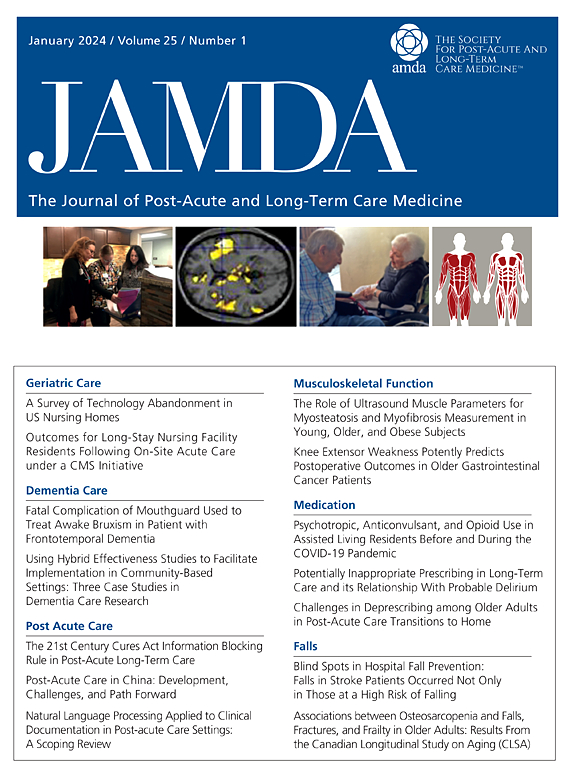IF 4.2
2区 医学
Q2 GERIATRICS & GERONTOLOGY
Journal of the American Medical Directors Association
Pub Date : 2025-02-08
DOI:10.1016/j.jamda.2024.105476
引用次数: 0
摘要
研究目的:先前的研究表明,尿失禁(UI)可能是老年社区居民入住养老院(NH)的一个风险因素。我们的目标是评估尿失禁是否是辅助生活(AL)居民入住养老院的独立风险因素,并评估不同种族/族裔的尿失禁对入住养老院的影响:这项回顾性队列研究基于 2019-2021 年的医疗保险注册和理赔数据:研究对象:2020 年 1 月 1 日至 2020 年 6 月 30 日期间居住在 AL 社区的医疗保险受益人,以及新诊断出 UI 的受益人。对所有居民进行跟踪调查,直至 2021 年 12 月 31 日,以确定永久性 NH 安置(住院时间≥90 天):方法:纳入个人协变量(年龄、种族/族裔、慢性病)和 AL 社区因素(床位规模、符合医疗保险和医疗补助双重资格的居民比例)。我们估计了带有个人和 AL 随机效应及稳健 SE 的逻辑回归模型。我们还估算了交互效应,以研究不同种族/族裔的 NH 安置差异:在 247010 名 AL 居民中,20.45% 的人患有 UI。总体而言,在研究期间,15.7% 的居民被永久安置在养老院;14.2% 的居民没有 UI,21.7% 的居民有 UI。在对混杂因素进行控制后,UI 显著(P < .01)增加了被安置到养老院的概率,与平均值相比增加了 14%。与没有 UI 的白人居民相比,有 UI 的白人居民获得 NH 安置的概率要高出 1.93 个百分点(pp)。虽然黑人和西班牙裔居民的安置风险总体较低,但有 UI 的居民的安置风险显著增加:黑人居民的安置风险比西班牙裔居民高 3.43 个百分点,比西班牙裔居民高 3.68 个百分点:这项在 AL 社区进行的首次也是规模最大的 UI 研究表明,UI 是永久性 NH 安置的一个独立风险因素。通过教育以及及早识别和治疗 UI,可使 AL 居民避免或推迟 NH 安置。本文章由计算机程序翻译,如有差异,请以英文原文为准。
Urinary Incontinence Is an Independent Risk Factor for Nursing Home Placement among Assisted Living Residents
Objectives
Prior studies suggested that urinary incontinence (UI) may be a risk factor for nursing home (NH) placement among older community-dwelling individuals. Our objectives were to evaluate if UI is an independent risk factor in NH placement among assisted living (AL) residents and assess the impact of UI on NH placement by race/ethnicity.
Design
This retrospective cohort study is based on the 2019-2021 Medicare enrollment and claims data.
Setting and Participants
Medicare beneficiaries residing in AL communities, and those with a new UI diagnosis, between January 1, 2020, and June 30, 2020, were identified. All residents were followed through December 31, 2021, to identify permanent NH placement (length of stay ≥90 days).
Methods
Individual covariates (age, race/ethnicity, chronic conditions) and AL community factors (bed size, proportion of Medicare-Medicaid dually eligible residents) were included. We estimated logistic regression models with individual and AL random effects and robust SEs. Interaction effects were estimated to examine differences in NH placement by race/ethnicity.
Results
Of 247,010 AL residents, 20.45% had UI. Overall, 15.7% of residents were permanently placed in NHs during the study period; 14.2% had no UI, and 21.7% had UI. After controlling for confounders, UI significantly (P < .01) increased the probability of NH placement, a 14% increase relative to the mean. Compared with white residents without UI, white residents with UI had 1.93 percentage point (pp) higher probability of NH placement. Although Black and Hispanic residents overall had lower risk of placement, that risk increased significantly for residents with UI: 3.43 pp higher for Black residents and 3.68 pp higher for Hispanic residents.
Conclusions and Implications
This first and largest study of UI in AL communities demonstrated that UI is an independent risk factor for permanent NH placement. Education and identifying and treating UI early may allow AL residents to avoid or delay NH placement.
求助全文
通过发布文献求助,成功后即可免费获取论文全文。
去求助
来源期刊
CiteScore
11.10
自引率
6.60%
发文量
472
审稿时长
44 days
期刊介绍:
JAMDA, the official journal of AMDA - The Society for Post-Acute and Long-Term Care Medicine, is a leading peer-reviewed publication that offers practical information and research geared towards healthcare professionals in the post-acute and long-term care fields. It is also a valuable resource for policy-makers, organizational leaders, educators, and advocates.
The journal provides essential information for various healthcare professionals such as medical directors, attending physicians, nurses, consultant pharmacists, geriatric psychiatrists, nurse practitioners, physician assistants, physical and occupational therapists, social workers, and others involved in providing, overseeing, and promoting quality

 求助内容:
求助内容: 应助结果提醒方式:
应助结果提醒方式:


